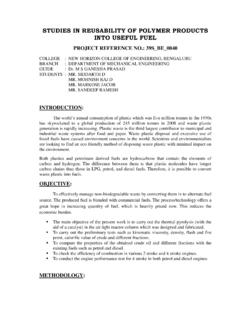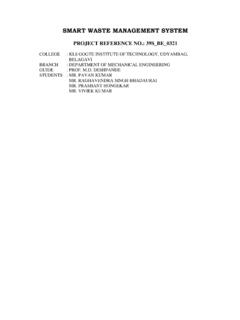Transcription of DESIGN AND FABRICATION OF CALORIMETER …
1 DESIGN AND FABRICATION OF CALORIMETER FOR. impinging OF FLAME JET. PROJECT REFERENCE NO.:39S_BE_0667. COLLEGE : HIRASUGAR INSTITUTE OF TECHNOLOGY, NIDASOSHI. BRANCH : DEPARTMENT OF MECHANICAL ENGINEERING. GUIDE : PROF. R V NYAMAGOUD. STUDENTS : MR. KIRAN C GANIGER. MR. ALLAUDDIN D MUTANI. MR. GURURAJ S KATTI. MR. VIRESH K DOLLINNAVAR. OBJECTIVES: By studying the various literatures there no one conducted the experiments on spiral type of counter flow heat exchanger on impinging of flame jet so we estimated to achieve the following objectives 1. By varying the flame distance and varying the fluid flow rate we can get various heat flow rate 2. To maintain the constant temperature over the target plate.
2 3. To determine the relative importance of thermal radiation 4. To determine how the thermo chemical heat release is affected by the surface properties of the target 5. To reduce the heat loss from the surface of heating 6. To find out the heat flux at the target METHODOLOGY: Set up A schematic diagram of the apparatus is shown in fig 1. Fluid comes from the high head tank which will be controlled by the main control valve. The fluid then flows from main control valve to experimental set up through hose pipe by controlling the sub control valve. the rate of fluid comes from the sub control valve with same flow rate enters as an inlet and will passes through spiral shape passage and finally exit through outlet with same flow rate.
3 For taking the different set of readings the fluid flow rate can be varied. Here for heating the target plate we use the LPG gas mixture with air which will passes through the hosh pipe to the burner, in between the hosh pipe we used calibrated orificemeter with two pressure taps, the orificemeter is used for measuring the amount of fuel consumption to heat the target plate which is calculated by the differential head of the manometer readings where it is connected with two hosh pipes one as inlet and the other one as outlet to the orificemeter pressure taps. By this experimental set up we take three sets of reading 1. By keeping constant fluid flow rate with varying flame length. 2. By keeping constant flame length with varying fluid flow rate.
4 3. By varying both the fluid flow rate and flame length. RESULTS: The CALORIMETER which is commonly used in all heat treatment, which will have the common heat function, as the Z/d value changes (distance between target plate and torch). there will be change in heat distribution to the target plate, and is also depends on the diameter d of the torch, This is the first study to investigate the effects of the target material and surface condition on the spiral type passage for flames impinging normal to a plane surface. The results show that the heating process should not be significantly affected by the target composition.





